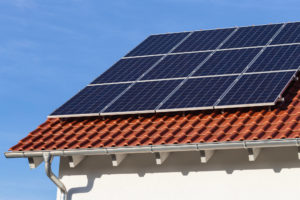Snail trails on solar panels are not what they seem at first glance. Instead of a slimy trail left by an actual snail, this term refers to the brownish lines of discoloration found on solar panels. These snail trails have become a significant phenomenon, often appearing on solar panels after a couple of years of use. The snail trail effect can warn of further damages like microcracks, impacting solar panel efficiency and leading to PV module discoloration.
Contents
- 1 Key Takeaways
- 2 Causes of Snail Trails on Solar Panels
- 3 Power Degradation Caused by Snail Trails
- 4 Prevention and Reliability of Solar Panels
- 5 The Future of Clean Energy: Beyond Snail Trails
- 6 Case Study: Addressing Snail Trails in Residential Solar Installations
- 7 Expert Insights From Our Solar Panel Installers About Snail Trails on Solar Panels
- 8 Experience Solar Excellence with Us!
- 9 Conclusion
- 10 FAQ
Key Takeaways
- Snail trails on solar panels, caused by a chemical reaction involving silver acetate and silver carbonate, lead to brownish discoloration and affect solar panel efficiency and PV module performance.
- Despite the challenges in preventing snail trails and other common damages, solar panels remain vital to clean energy, with benefits like cost-effectiveness and reducing carbon footprints.
- The future of solar energy requires redesigning solar panels, using more protective materials, and using innovative technologies like PV trackers to increase overall productivity and overcome defects like snail trails.
Causes of Snail Trails on Solar Panels
Chemical Reactions Leading to Discoloration
Snail trails are a result of complex chemical reactions. The discoloration is primarily caused by silver acetate forming, synthesized by silver carbonate. This chemical reaction leads to the snail trail effect, making the solar panels brownish. Depending on the severity, snail trails may not always damage the function of solar panels but can be a significant defect in appearance.
Interaction with Silver Acetate and Carbonate
The presence of carbon dioxide, Ag ions, and acetic acid, derived from the degradation of solar panels, leads to the formation of silver acetate. This reaction with silver carbonate causes the snail trails and can even lead to cracks, further lowering the power of solar panels that have developed these trails.
PV Module Performance Degradation
The snail trail effect on crystalline silicon solar panels, commonly used in energy plants, can cause performance degradation. This flaw has led many solar panels in use not to perform as well as they should, impacting the overall efficiency of the solar module.
Power Degradation Caused by Snail Trails
Snail Trail Effect on Crystalline Silicon Solar Panels
When snail trails are formed, they are responsible for solar panel power degradation. Power degradation is the damage to solar panels, preventing them from functioning normally. Despite being a powerful force, the crystalline silicon solar module is highly susceptible to snail trails and other defects.
Solar Panel Design Flaws
The makeup of solar panels can contribute to their susceptibility to snail trails. Panels often have little protection implemented in their design, with crystalline silicon solar cells being extremely thin and prone to damage like microcracks. The material known as silicon is weak and brittle, often damaged during transportation or exposure to strong weather.
Snail Trails and Module Performance
Snail trails can significantly impact module performance. They are a common issue in solar plants, decreasing solar panel efficiency. The design of solar panels and the environment they are used in don’t help prevent power degradation, making snail trails a persistent problem.

Prevention and Reliability of Solar Panels
Are Snail Trails Preventable?
Preventing snail trails on solar panels is a complex task. Due to their outdoor use, they can’t be fully protected from nature’s elements. Ironically, heat, humidity, and UV radiation support the chemical reaction that causes snail trails. The design of solar panels and the materials used, such as EVA and back sheet, contribute to this challenge.
Common Damages: Hot Spots, Inner Corrosion, Broken Glass
Solar panels can develop other common damages as well. Hot spots, inner corrosion, broken glass, and snail trails are frequent issues. These damages lower a solar panel’s ability to function at peak performance, further questioning their reliability.
Solar Panel Efficiency and Lifespan
Research shows that modern solar panel models convert only 20% of sunlight into usable energy. This efficiency can drop further due to defects like snail trails, microcracks, and acetate reactions. The lifespan of solar panels, averaging 20 to 30 years, also raises questions about their worth as an investment.

The Future of Clean Energy: Beyond Snail Trails
Benefits of Solar Power
Solar energy offers endless benefits, including working in various climates, cost-effectiveness, reducing carbon footprints, and increasing property value. However, the current technology must be improved to realize these benefits fully.
Flaws of Solar Power
Solar panels, while eco-friendly, are not as powerful as once thought. Global warming demands clean energy sources, but the current design of solar panels, including issues like snail trails and brownish discoloration, must be rethought.
Redesigning Solar Panels for Efficiency
The future of solar energy lies in redesigning solar panels. More protective materials and innovative technologies like PV trackers can increase overall productivity. New advancements will likely fix issues like snail trails, making solar power an ultimate energy source.
Case Study: Addressing Snail Trails in Residential Solar Installations
Background
At Solar Panels Network USA, we aim to provide high-quality, reliable solar solutions for our clients. Recently, we encountered a case where a residential solar installation began exhibiting snail trails just a few years after installation. The homeowners were concerned about the potential impact on their system’s performance and sought our expertise to address the issue.
Initial Assessment
Identifying the Problem
Upon inspection, we identified brownish lines of discoloration on several panels, characteristic of snail trails. We conducted a thorough analysis to understand the extent of the damage and its impact on the solar system’s efficiency. Using advanced diagnostic tools, we traced the issue back to microcracks and chemical reactions involving silver acetate and silver carbonate.
Assessing System Performance
We performed a detailed performance assessment to quantify the impact of the snail trails on the system’s output. Our findings indicated a noticeable decline in efficiency, corroborating the homeowners’ concerns about reduced energy production.
Implementation
Replacing Affected Panels
Based on our assessment, we recommended replacing the most severely affected panels. We sourced high-quality panels from a reputable manufacturer known for their durability and resistance to common solar panel issues like snail trails and microcracks.
Enhancing Installation Techniques
To prevent recurrence, we implemented enhanced installation techniques. This included using improved sealing methods to protect against moisture ingress, a key factor in the formation of snail trails. Additionally, we ensured that the new panels were installed with optimal support to minimize stress and potential microcracks.
Ongoing Monitoring and Maintenance
We established a proactive maintenance schedule, including regular inspections and performance monitoring. This approach aimed to identify any early signs of issues, allowing for prompt intervention and minimizing the risk of significant efficiency losses.
Results
Improved System Efficiency
Following the replacement and enhanced installation techniques, the solar system’s performance improved significantly. The homeowners reported a return to expected energy production levels, alleviating their concerns about efficiency and reliability.
Increased Lifespan and Reliability
The proactive measures taken during installation and ongoing maintenance helped extend the lifespan of the solar panels. By addressing the root causes of snail trails and ensuring robust installation practices, we enhanced the overall reliability of the system.
Homeowner Satisfaction
The homeowners expressed high satisfaction with the resolution of the issue and the improved performance of their solar system. They appreciated the thorough approach taken by our team, which not only addressed the immediate problem but also implemented measures to prevent future occurrences.
Summary
This case study highlights the importance of addressing snail trails on solar panels promptly and effectively. By replacing affected panels, enhancing installation techniques, and establishing a proactive maintenance schedule, we restored the system’s efficiency and ensured its long-term reliability. Our commitment to high-quality materials and innovative solutions underscores the value of expert intervention in maintaining the performance and longevity of residential solar installations.
Expert Insights From Our Solar Panel Installers About Snail Trails on Solar Panels
Snail trails on solar panels are more than just cosmetic issues. They often indicate underlying problems such as microcracks and chemical reactions that can significantly degrade the efficiency and lifespan of the panels. It’s crucial to address these issues promptly to maintain optimal performance.
Senior Solar Installation Engineer
Preventing snail trails involves using high-quality materials and ensuring proper installation techniques. Regular maintenance and monitoring can help identify early signs of snail trails, allowing for timely interventions to mitigate further damage.
Solar Maintenance Specialist
Understanding the chemical reactions that lead to snail trails is vital for developing more durable solar panels. Innovations in materials science and improved manufacturing processes are essential to overcoming these challenges and enhancing the reliability of solar energy systems.
Solar Technology Researcher
Experience Solar Excellence with Us!
Trust in Solar Panels Network USA, where our seasoned experts deliver top-quality solar solutions for homes and businesses nationwide. With a legacy of countless successful installations and a commitment to sustainable energy, we’re your reliable partner in the solar journey. Ready for a brighter, eco-friendly future? Call us now at (855) 427-0058 and harness the power of the sun!
Conclusion
Snail trails on solar panels are more than a mere aesthetic issue. They symbolize a broader challenge in the solar energy industry, reflecting the need for improved design, materials, and technology. Understanding the causes and impact of snail trails, from chemical reactions to brownish discoloration, we can work towards a future where solar panels are more efficient, reliable, and free from defects like snail trails. The path to clean energy is bright but requires innovation, investment, and a commitment to overcoming the challenges that snail trails represent.
FAQ
Do snail trails affect solar panels?
Yes, snail trails do affect solar panels. They are brownish lines of discoloration found on solar panels, often appearing after a couple of years of use. Snail trails can warn of further damages like microcracks and impact solar panel efficiency and PV module performance.
What causes snail trails on solar panels?
Complex chemical reactions cause snail trails on solar panels. The discoloration is primarily caused by the formation of silver acetate synthesized by silver carbonate. This reaction leads to the snail trail effect, giving the solar panels a brownish appearance and can be considered a significant defect.
What are the burn marks on solar panels?
Burn marks on solar panels, often called “hot spots,” are areas that develop due to excessive heat. These spots occur commonly because of manufacturing defects, prior damages, and bad connections in the cells of a solar panel. Hot spots are one of the worst damages to solar panels and are a significant contributor to panel replacement.
What causes hot spots on solar panels?
Various factors, including manufacturing defects, prior damages, and bad connections in the cells of a solar panel cause hot spots on solar panels. They develop due to excessive heat and can put the panels at risk of being destroyed by a short circuit. Hot spots are a common issue and can significantly impact the efficiency and lifespan of a solar panel.
About the Author
Solar Panels Network USA stands at the forefront of solar energy solutions, driven by a team of seasoned solar engineers and energy consultants. With over decades of experience in delivering high-quality solar installations and maintenance, we are committed to promoting sustainable energy through customer-centric, tailored solutions. Our articles reflect this commitment, crafted collaboratively by experts to provide accurate, up-to-date insights into solar technology, ensuring our readers are well-informed and empowered in their solar energy decisions.

